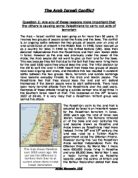This links to what happened in the war itself, after the immediate attack by the Arabs. Initially, the war was very close, but after 2 weeks, Bernadotte from the UN called a truce. During this time, Israel was able to receive the weapons it had ordered from Czechoslovakia, from Skoda. These weapons were very effective, and after the truce had ended with the assassination of Bernadotte, the Arabs were easily pushed back. The Arab were united under the command of King Abdullah of Jordan, but it was apparent that the Arab states were fighting for their own gain rather than the greater good of the Arab states. Therefore, even though the Arab forces were 3 times as large as the Jewish army, their efforts still failed
This links to the next key feature, which happened as a result of the Arab defeat. The Jews were able to push the Arabs out of Northern Israel and the Negev Desert, meaning that all the Arabs were now living in the West Bank and Gaza. This, in conjunction with the massacre at Deir Yassin, eventuating in the mass fleeing of 700000 Palestinian Arabs resulted in the creation of the state of Israel, which ended up being much larger than initially laid out by the UN Partition Plan, due to the land gains made
Overall, the key features of the First Arab Israeli War were that it was caused by Arab rejection of the state of Israel and the implementation of the UN Partition Plan, linking to what happened as a result of this Arab rejection, which was the war, where the Israelis were dominant, linking to what occurred the result of this Israeli dominance, which was the large land gains made for the new state of Israel.








